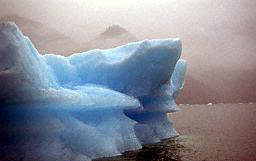
(Courtesy of Yahoo! Picture Gallery)

|
LeConte Glacier Bay in Alaska is a 12 mile-long fjord carved out of the coastal mountain range by glaciers over the course of thousands of years. LeConte Glacier is North America's southern most tidewater glacier. Harbor Seals are viewed here on the icebergs "sunning" themselves, often up to 400 on one berg. Actually, they use LeConte Bay as their breeding, birthing and rearing area. The 19th-century naturalist John Muir recommended to Lt. Commander C. M. Thomas, who was mapping Alaska for the US Coast & Geodetic Survey, that the bay and glacier be named for his friend, Joseph LeConte, a geologist at the University of California at Berkeley. In 1995 LeConte Glacier suddenly shrank, retreating a half-mile in five months. In 1998, it retreated nearly one mile more and thus became one of the fastest-retreating glaciers in the world, Its forward flow rate in 1998 was determined to be 81 feet per day, but it retreated faster than its flow rate because of extremely active calving. LeConte Glacier's ice extends 500 to 700 feet below the surface of LeConte Bay. This leads to submarine calving, producing what are locally called shooters, icebergs that rise rapidly to the surface as far out as 1000 feet from the glacier's face. Surface terminus height above sea level averages 150 to 200 feet. |